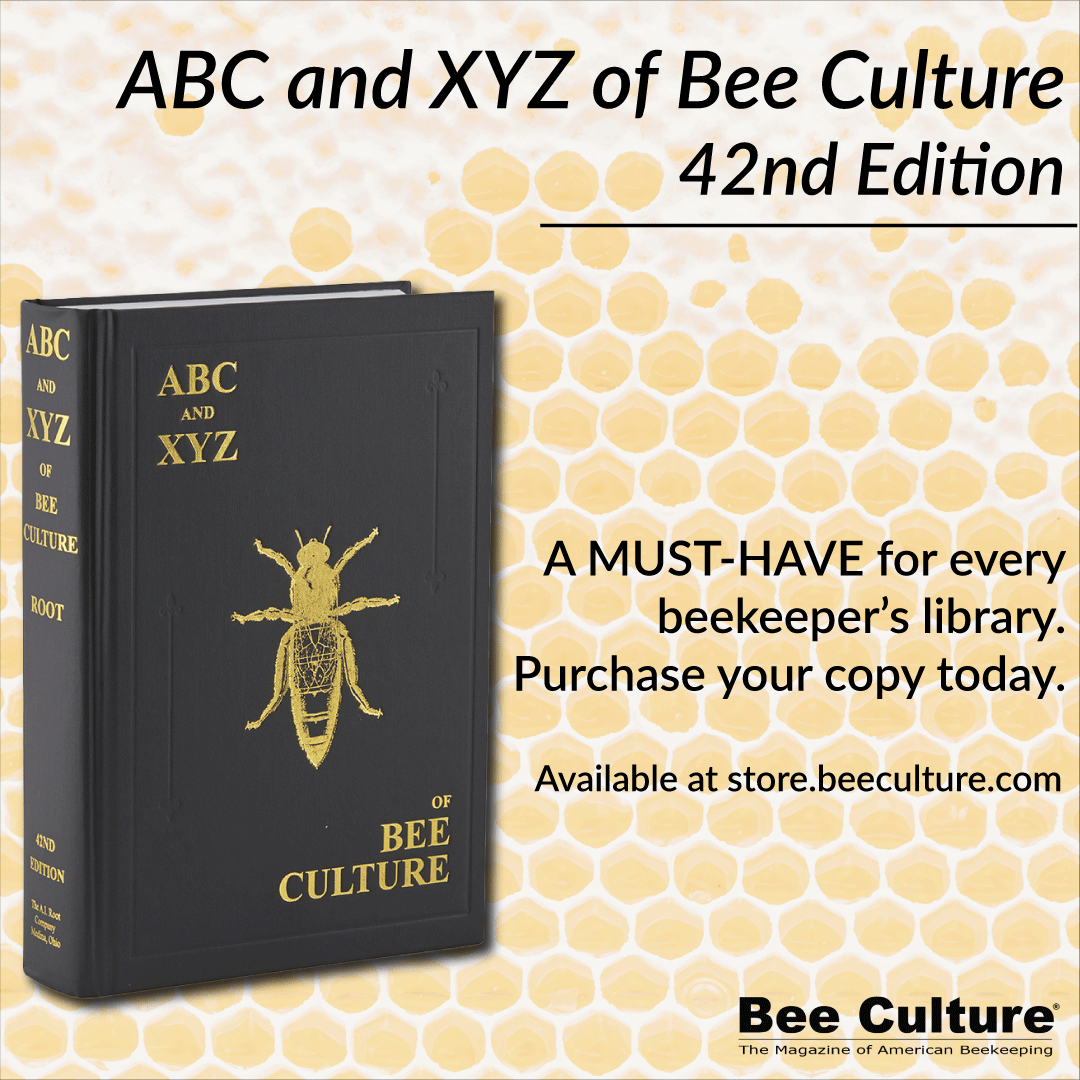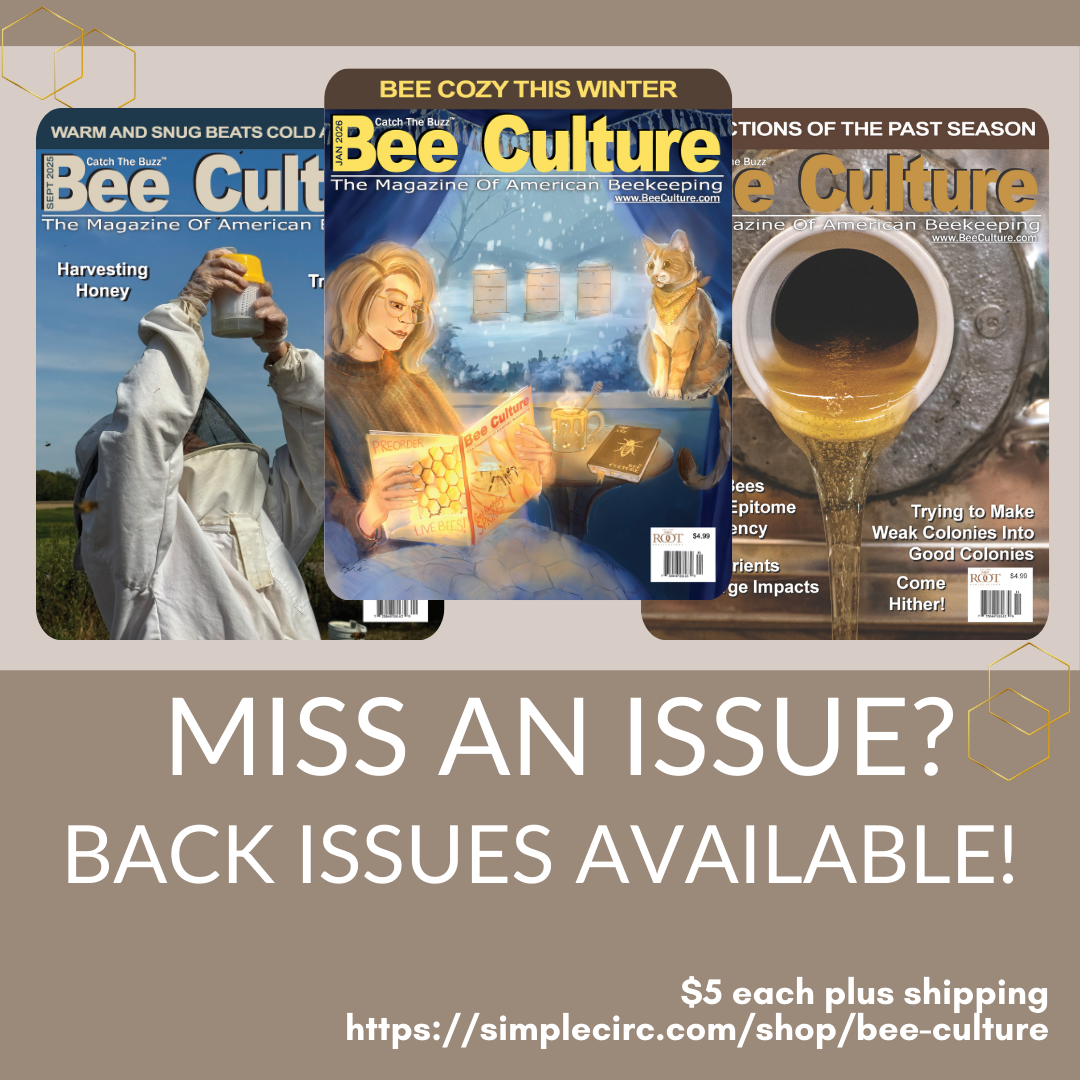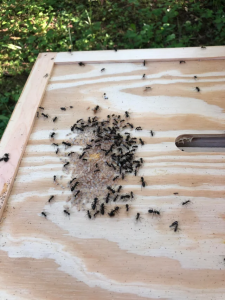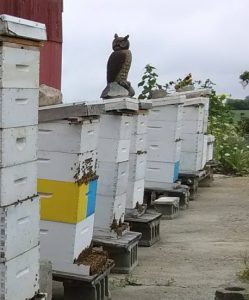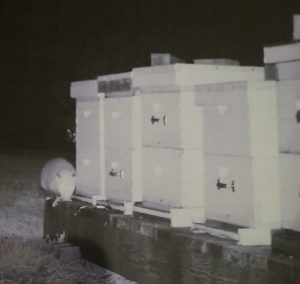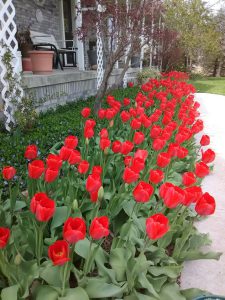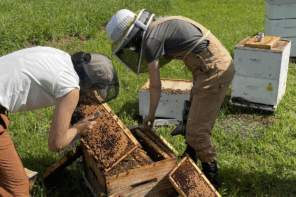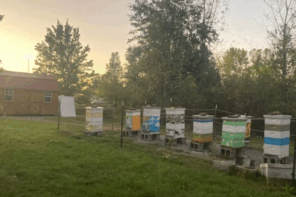New(ish) Beekeeper Column
Ridding Critters of the Beeyard
Richard Wahl
Much has been written about invasive pests inside the beehive such as varroa mites, wax moths and hive beetles. There is not as much about those animals and critters which exist outside the hive that present a hazard to our bees or can become invasive. So, in this issue, I will delve into a few of the outside arthropods, birds and beasts that can pose a threat to one’s beehives depending on your proximity to their habitats. Some of this is a result of my own experiences in beekeeping management with a few asides that we would never expect to encounter here in SE Michigan. Possibly, you will find a few remedies here that will help if your hives are being invaded by uninvited guests.
Arthropods
Honey bees as well as other bee species and ants fall under the phylum classification (Arthropoda) of invertebrate animals such as insects, arachnids and crustaceans, that have a segmented body and jointed appendages, usually an exoskeleton molted at intervals and a dorsal anterior brain. Included in this phylum, other bee species such as wasps, yellow jackets and bald faced hornets are attracted to the honey in beehives. Since I covered how to make a wasp trap out of a two liter soda bottle in the December issue, I will not repeat that topic here. Suffice it to say that my experience is that honey bees do not seem to be attracted to solutions in a wasp trap that do attract other types of invasive bees. Although the Fall season is when most wasps and yellow jackets are most actively seeking out honey from beehives, placing a trap out in the Spring, once your honey bees become active, may enable the capture of overwintered female queen yellow jackets or wasps before they begin to establish nests that will be populated by many more invasive bees in the Fall. Ants are another insect in this classification that can decide to invade the beehive. I have found ants establishing themselves in my one inch thick foam insulation slabs just under the outer cover. On one occasion, I had not removed the screen taped to the top of an inner cover and ants decided to set up housekeeping and the laying of eggs between the inner and outer covers where the bees had no access.
There are several ways in which to dissuade ants from visiting your hives. If the beekeeper can spot the trail of ants moving to and from the hive to their nest, the nest can be treated with any number of non-chemical ant repellents. Ants give off a pheromone just as bees do so their partners can follow a trail to a food source, in this case the beehive. Diatomaceous earth kills ants by absorbing the oils in their exoskeletons. Diatomaceous earth isn’t a poison. Food-grade diatomaceous earth can be found online. A glass cleaning spray mixed with liquid detergent (dish soap) can be sprayed on areas where ants seem to crawl, like on beehive legs or stands. Cinnamon or black pepper can be sprinkled liberally around the hive base or even on top of the inner cover as ants avoid the smell but bees don’t mind it. Any of these exterior applications will need to be reapplied after a rain as the rains will wash away powders or sprays. Any grease or lard type substance can be spread on hive stand legs to keep ants from crawling up onto the hives. I am aware of a few beekeepers who use a product called Tanglefoot, which is in this grease category, which claims to be non-chemical. If the beehive sits on legs each leg can be placed in a bucket or can and be surrounded with water to form a moat. Adding a few drops of detergent to the water decreases the surface tension so ants cannot build an ant body bridge across the water. This can happen if legs are too close to the container edge. A few ants in the hive are nothing to worry about. The honey bees will keep ants out of any portion of the hive that they populate and can easily reach, although the much smaller ant can still find crevices and cracks in which to reside and steal a bit of honey or nectar when the opportunity allows.
Mice, Voles or Shrews
As the weather turns colder, mice may search for a warmer space to make a nest. The beehive is a perfect place that also provides honey and nectar as a food source. During a colder part of the year, when bees are clustered and not as active, these small rodents may determine a beehive is a nice place to nest. They will chew out a corner of the bee frames and bring in nesting material. Urination may add a bad odor near the nesting area which they will not vacate until bees become more active on warmer Spring days. Although voles and shrews do not nest in hives they are insect eaters and will feast on bees if given the opportunity. In each case, the best solution is a preventative screen placed over the hive entrance that allows space for bees, but is not large enough for these small critters. For mice, a ½ inch wire mesh may be sufficient. But if your voles or shrews are of a smaller type the entrance holes may need to be reduced even farther to ¼ inch. In either case, once the weather warms and the bees become active enough to protect themselves, the entrance screens should be removed to allow the bees the space to do everything they want to do, such as removing dead bee bodies from the hive. This bee action can be assisted by using a curved ½ or ¾ inch flat slat to pull any dead bees out of the hive from the bottom entrance once or twice during those warmer Winter days. This goes a long way toward avoiding dead bees in the hive molding and spreading any inherent diseases.
Birds
Although there is no way to completely protect foraging honey bees from birds, I did find a solution for a group of barn swallows that were nesting under a barn eave just above the areas of my hives. I watched as they would swoop down and grab bees in flight while building their mud nests under the eave one Spring. Since there were no eggs or chicks in the nests at the time I knocked the nests down with a long pole. I had purchased one of those swivel head plastic garden owls and then set it on top of a hive in the middle of my beeyard. The swallows had a fit screeching at the owl predator the rest of the afternoon and did not come back the next day or any time thereafter to date. I noticed that small birds in general do not seem to frequent my apiary area with the plastic barn owl set out on the top of a central hive each Spring. I fastened a weight to the owl base to keep it from blowing over in winds.
Skunks, Possums and Raccoons
One Winter during my early beekeeping years, I noticed that the western most hive seemed to have fewer bees each time I checked on those one-or-so-a-month warmer Winter days when you can take a quick look to see if more food supply is needed. I did not notice until Spring inspections that there were scratches from a small critter on the side of the hive near the bottom entrance with no live bees to be seen. One Spring morning the smell of a skunk was a clue as to what type of interloper I had. The skunk would scratch on a hive which irritated the lethargic bees in colder weather and then provide a nice Winter banquet of bees slowly exiting the hive. I believe I lost two or three hives to the varmint that Winter. In Spring, it had finally gotten warm enough for the bees to become more active and able to sting the skunk with the anticipated odor that would be the skunk’s response. That Winter my bottom board hives were sitting flat on a cement pad. I have since made sure they are raised a bit which provides the bees a better opportunity to sting curious creatures under their belly as they stand on hind legs scratching to encourage bees to come out. Most animals have a much keener sense of smell than we humans. This animal attribute can be used against smaller creatures that invade the beeyard. I have a neighboring beekeeper who had problems with opossums. Even though the neighboring beekeeper erected a three foot chicken wire fence, the possum would still climb over the fence to get to their hives. Doing a bit of research it was found that possums have a strong sense of smell and will avoid areas with mothballs or bleach odor. Dropping a few mothballs a few feet from the hives seems to have negated any more problems with possums. I have read that this also works to keep skunks and raccoons away and have since used this technique around my hives. The trick is to not place the mothballs too close to hives as the smell can also deter the bees.
Bigger Beasts
Livestock such as cows and steers do not normally pose an interference with bees. However it is not unheard of for livestock to use a beehive as a scratching post and knock the resulting hive over. This will normally result in a quick retreat by the bovine if bees are active in warmer weather and proceed to sting the errant scratcher. A common need for both bees and livestock is water. In order to prevent altercations between bees and any type livestock, a water source for the bees near the hives is a good policy. Also, fencing off the beehive area so that curious livestock cannot get near the hives is a good plan. Horses are another consideration. Darryl Gabritsch wrote a very nice piece for Bee Culture Magazine in the February 2018 issue on Honey Bees and Horses, so I will not reiterate his informative article here. Fortunately in my portion of SE Michigan, we do not have a problem with bears. Bears have a liking for larval bees and honey and are able to smell out hives even if some distance away from their home range. The only method I am aware of for those who may live in bear country is to maintain a substantial electrified fence to keep bears at bay. The electrified fence will require three or four strands of electrified wire. Michigan State University, in cooperation with Michigan Department of Natural Resources, designed and tested an electric fence option for black bears that can be found at: https://www.michigan.gov/dnr/-/media/Project/Websites/dnr/Documents/WLD/Bear/apiary_brochure.pdf.
Rabbits, Deer and Elephants
I would be remiss if I did not mention critters that do not necessarily bother beehives, but do like to eat those plants that bees rely on for nectar and pollen. It stands to reason that if bees are attracted to pollen producing plants that these same plants would attract herbivores or animals that rely on plants for their diet. My own experience is with deer and rabbits who like to munch on the same flowering plants and tree saplings that would eventually provide a nectar source for bees. One year, I did not fence my raspberry patch with chicken wire fencing and the rabbits chewed off the three to four foot raspberry shoots to the snow cover of about six inches. That Summer, I got no raspberries since the tall overwintered shoots provide the following Summer’s raspberry crop. When I first planted sapling basswood and some apple trees in my backyard years ago, the deer chewed on most of the saplings. A six inch wire mesh fence around tree saplings solved this problem and also prevents the deer from rubbing on two-to-three-inch diameter older trees to mark their territory or to remove yearly antlers. Deer also like to nibble on some of the early Spring flowers like tulips. I have several tulip beds at the front of my house and every five or six years dig and replant as they get crowded and decrease in blossoms. One year, I saved the smaller bulbs and transplanted them in a back vacant garden spot to grow into bigger bulbs. In their second year of growth, they were all nibbled to the ground by deer. This was not the case the first year when they were not touched as I had cut several bars of Lever Brothers soap into eighths and placed pieces every six to eight feet throughout the tulip bed.
Placing soap bar pieces in the bed in following years negated the rabbits having their Spring breakfasts on my tulips. I also have found that placing ¼ chunks of soap bars in tube socks and tying two or three of these to my apple tree saplings has kept the deer from munching on them. Lever Brothers or Irish Spring soaps seem to have the strongest odor and work the best. I have read of a beekeeper in another state that used fencing to keep deer out.
The issue there is that the fences needed to be ten feet high to keep deer from jumping over them. He solved this problem using electrified two wire fencing with a second electrified single wire about five feet farther out. It seems deer avoid a double fenced area, not able to discern how high the second inner fence reaches.
One four legged herbivore that we do not need to worry about in our area is the elephant. Research done by Dr. Lucy King in Kenya has found that if beehives are placed every ten to fifteen feet (32 to 49 meters) apart elephants can be kept away from crop areas. Connecting wires between the hives assists in disturbing bees if any portion of the wire is moved or jarred. Exiting bees will sting the elephants in the most sensitive areas around their eyes, behind their ears and even on and in their trunks. Once an elephant has experienced a sting or two, they will retreat from just the sound of the bees leaving a hive and seem to be able to pass this cautionary retreat response on to their offspring. I am sure most of those reading this are not dealing with elephants. But hopefully this article has provided you with a few techniques that will help protect your bees from any type of predator. As always, your experience may vary based on your environment, state of your hives and the type of critter with which you are dealing. Best of luck to you all with your bee and critter management as we very soon move into our next beekeeping season.

